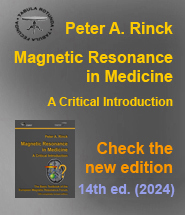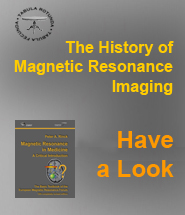Glosario
| a | b | c | d | e | f | g | h | i | j | k | l | m | n | o | p | q | r | s | t | u | v | w | x | y | z |
L
LAO: left anterior oblique (projection through the human body).
Larmor equation: states that the frequency of precession of the nuclear magnetic moment is proportional to the magnetic field.
ω0 = -γ × B0 (radians per second); or
ν0 = -γ × B0/2π (Hertz),
where ω0 and ν0, respectively, are the frequency, γ is the gyromagnetic ratio, and B0 is the magnetic induction field. The negative sign indicates the direction of rotation.
Larmor frequency (ω0 or ν0): the frequency at which magnetic resonance can be excited; given by the Larmor equation. By varying the magnetic field across the body with a gradient magnetic field, the corresponding variation of the Larmor frequency can be used to encode position. For protons (hydrogen nuclei), the Larmor frequency is 42.58 MHz/ Tesla.
Lattice: the magnetic and thermal environment with which nuclei exchange energy in longitudinal relaxation.
Line imaging → Sequential line imaging.
Line scanning → Sequential line imaging.
Line width: width of line in spectrum; related to the reciprocal of the transverse relaxation time (T2* in practical systems). Measured in units of frequency, generally at the half- maximum points.
Localized spectroscopy: the acquisition of spectra from a region within a sample. The region is usually defined using selective RF pulses and field gradients.
Longitudinal magnetization (Mz): component of the macroscopic magnetization vector along the static magnetic field. Following excitation by RF pulse, Mz will approach its equilibrium value M0, with a characteristic time constant T1.
Longitudinal relaxation: return of longitudinal magnetization to its equilibrium value after excitation; requires exchange of energy between the nuclear spins and the lattice.
Longitudinal relaxation time → T1.
Lorentzian line: usual shape of the lines in an NMR spectrum, characterized by a central peak with long tails; proportional to 1/[(1/T2)² + (ν-ν0)²], where ν is frequency and ν0 is the frequency of the peak (i.e. central resonance frequency).
Missing terms? Send us an e-mail. We'll add them ...











